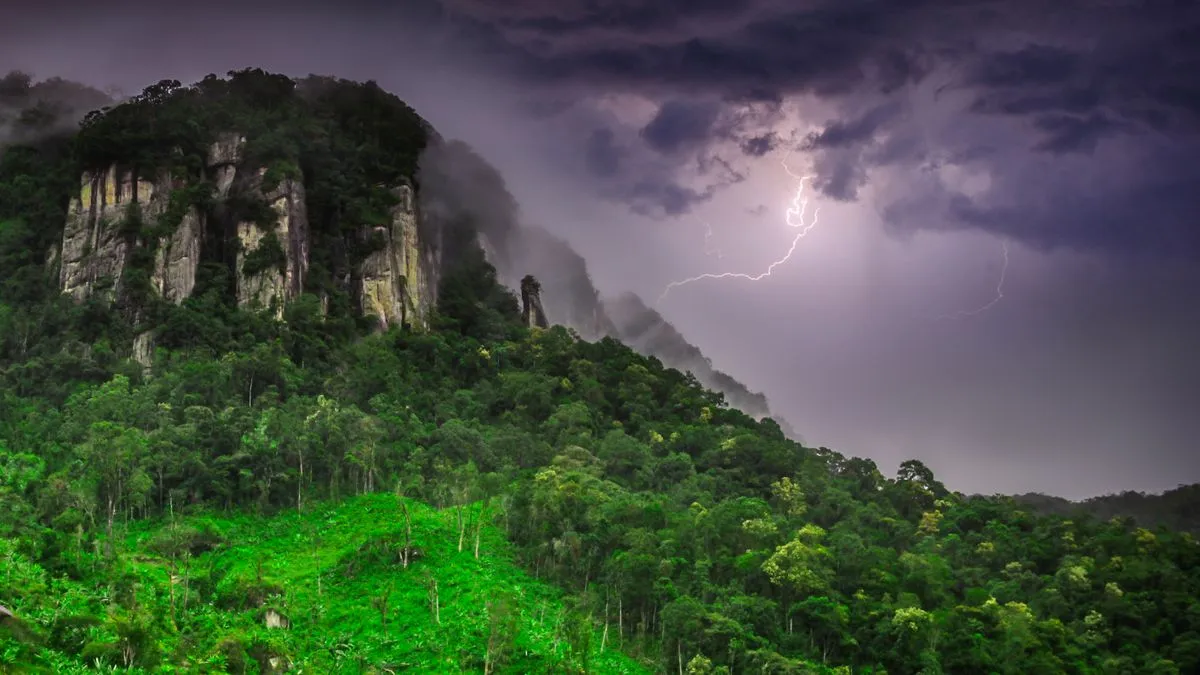
Lightning is typically viewed as a destructive force in forests, often leading to the death or damage of trees in its path. However, in the lowland rainforests of Panama, one towering tropical tree species, the tonka bean tree (Dipteryx oleifera), appears to have evolved a unique ability to harness this force of nature to its advantage. Recent research suggests that these remarkable trees not only survive lightning strikes but may actually benefit from them.
Published on March 26 in the journal New Phytologist, the study reveals that the tonka bean tree often emerges unscathed from lightning encounters. Instead of suffering damage, these trees seem to thrive while simultaneously harming their competitors and the parasitic vines that invade their branches. Study lead author Evan Gora, a forest ecologist at the Cary Institute of Ecosystem Studies, explained to Live Science that over a decade of research highlighted a shocking trend: while lightning kills many trees, particularly large ones, Dipteryx oleifera consistently showed remarkable resilience.
In tropical forests, lightning is a leading cause of tree mortality, particularly affecting the largest and oldest trees that play critical roles in carbon storage and biodiversity. The implications of understanding how lightning influences forest structure and species composition are vital, especially regarding the resilience of these ecosystems amid climate change. Amid the destructive backdrop, the researchers noted the surprising success of the tonka bean tree.
To explore this phenomenon, the researchers utilized a custom-built system of electric field sensors and cameras to track nearly 100 lightning events in Panama's Barro Colorado Nature Monument. They developed a high-resolution detection system involving an antenna array placed throughout Central Panama to capture radio waves produced by lightning strikes. By analyzing the energy patterns from each sensor, they accurately triangulated where each lightning bolt struck. This data, combined with on-ground surveys and drone imagery, allowed them to monitor the condition of trees over time in the affected areas.
The findings revealed that D. oleifera stood out as a species that consistently suffered little to no damage post-strike. To understand the long-term effects of lightning on these trees and their neighboring flora, the researchers reviewed decades of tree plot records. They discovered a quantifiable risk associated with living near Dipteryx oleifera: trees in proximity to this species had a significantly higher likelihood of dying compared to those near other large trees. On average, each lightning strike resulted in the death of over 2.4 tons (2 metric tons) of nearby tree biomass and nearly 80% of the lianas, or parasitic vines, infesting the tonka bean's canopy.
Gora speculated that the tonka bean tree's resistance to lightning may stem from its physical structure. Past studies indicated that these trees have high internal conductivity, allowing lightning currents to pass through them without generating damaging heat—similar to how a well-insulated wire operates. With the ability to grow up to 130 feet (40 meters) tall and live for centuries, a mature tonka bean tree could be struck by lightning at least five times, each strike helping to eliminate competition and opening up the canopy for its growth.
Moreover, the researchers estimated that being struck by lightning could lead to a 14-fold increase in the tree's lifetime seed production, providing a significant reproductive advantage. Gregory Moore, a horticulturalist from the University of Melbourne who did not participate in the study, suggested that these findings may also extend to other tree species. He noted that similar research could apply to tree-dominated plant communities, including woodlands where trees are more widely spaced.
Gora and his colleagues are now broadening their research to explore whether other species in different forests, including those in Africa and Southeast Asia, might also benefit from lightning strikes. As understanding of the unique relationship between lightning and the tonka bean tree expands, it opens new avenues for investigating the resilience and adaptability of forest ecosystems in the face of climate challenges.